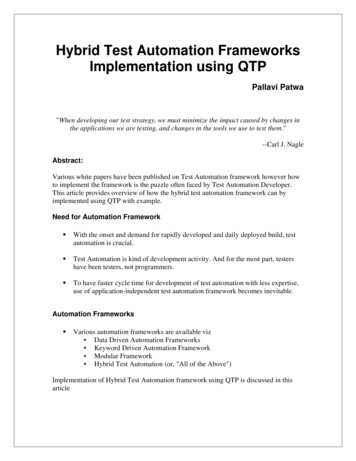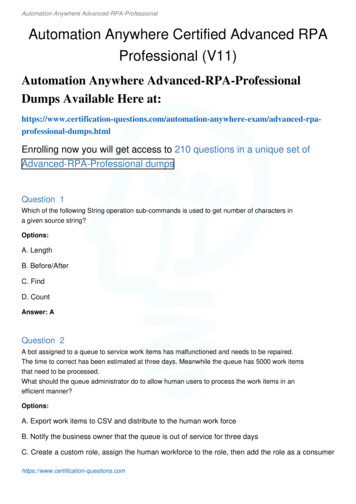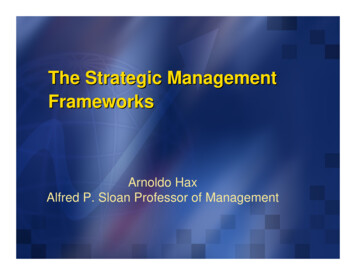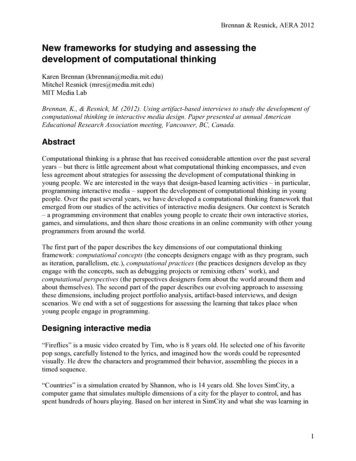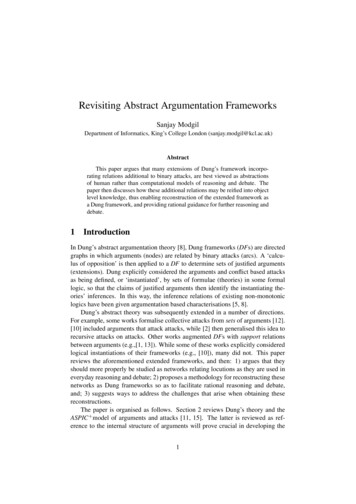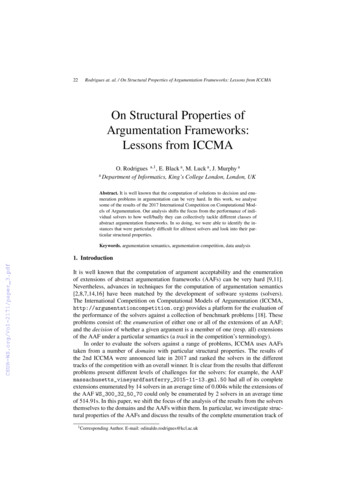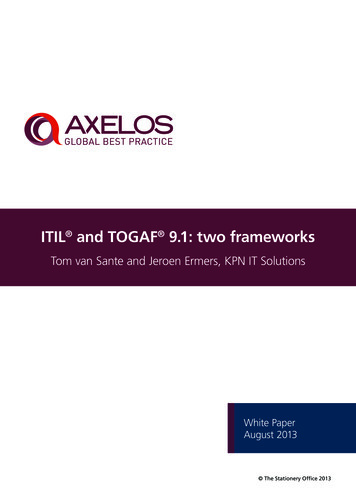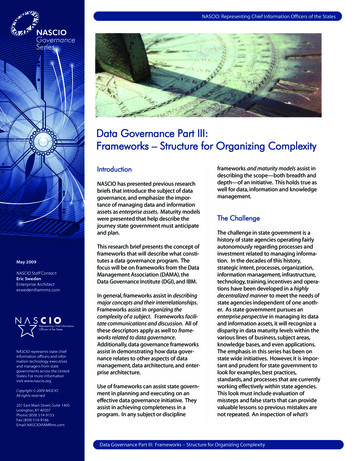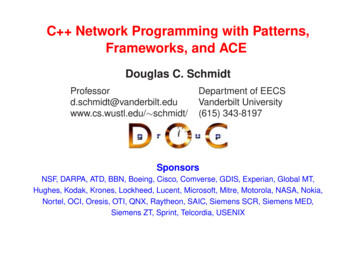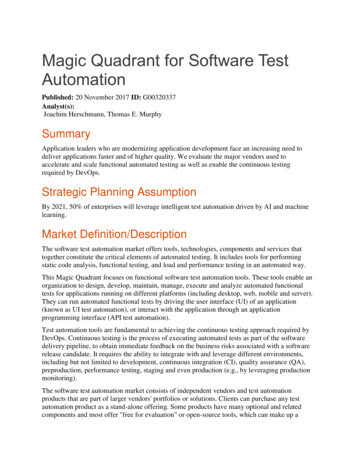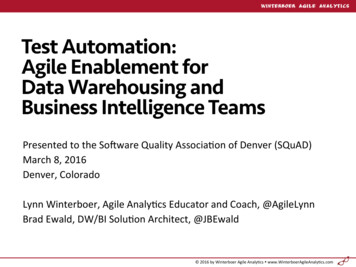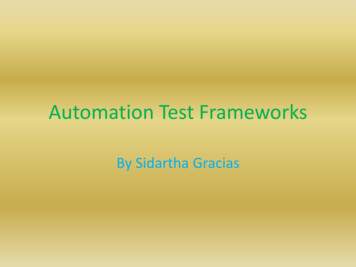
Transcription
Automation Test FrameworksBy Sidartha Gracias
Automation Testing Traditionally performed with tools that mimic manual testflows using a record and play-back system similar to marcorecording in excelHow does this work Capture manual test flow, using record capability. While recording, captures object on which actions areperformed and stores them in an object repository. On playback objects on page checked against OR for match. Tools then generates user actions on objects (e.g.buttonclick) to replicate test flow. Test scripts can be customized to use multiple data sets forthe same test flow or to modify test flow.
The Problem? Test Automation has for the most part been a failure.Why? Automation tools have been oversold. They have beengiven capabilities that they do not necessarily posses.E.g. demonstrate capabilities on one system andbelieve that would extend to all systems. Record and Playback looks great but performs poorly inpractice. Work great for small projects but scales poorly. Do not port well from one project to another. Hard to customize
The Solution - AutomationFrameworksThe Ideabuild a layer over existing automation tools. Tools still used (in the general case) to capture objectproperties Framework Provides a library of functions that hidesunderlying complexity from users. Modular design makes it easy to extend User friendly interface and reporting options Uses Global parameters and variables to compensatefor changes in application.
TestManagementInterfaceMessages/LogsKeywordScript KeywordInterpreterTest DriverAutomationToolApplicationUnder TestFunctionLibrary
The Good Much easier to extend to larger projects. Designed to be highly modular, so changes inthe application are easier to deal with. Highly customizable, easy to modify acrossprojects. Reduced maintenance costs. Isolates technical nitty-gritty of test casescripting from test execution.
The Bad Adds additional overhead of testers having tounderstand the framework Performs poorly when application changesoften as test scripts must be continuallymodified Often sold as a panacea, Automation testinghowever takes time and effort no matter howyou do it.
Different Ways to Design A Framework Test Script Modularity FrameworkData-Driven Automation FrameworksKeyword-Driven Automation FrameworkHybrid Test Automation Framework
Test Script Modularity Framework Builds a abstraction layer in front of a componentto hide the component from the rest of theapplication. Done by creating small, independent scripts. Each script represent modules, sections, andfunctions of the AUT. Small scripts can be combined to from larger tests Results in high degree of modularization andmaintainability.
Data-Driven Automation Frameworks Test input and output values are read fromdata files (ODBC sources, CVS files, Excel files,DAO objects, ADO objects. These values loaded into correspondingvariables in captured scripts. Test flow navigation coded into test script. Thus script is just a "driver," or deliverymechanism, for the data.
Keyword-Driven AutomationFramework Requires the development of data tables andkeywords, independent of the test automationtool. Essentially represents a manual test case as aseries of keywords or actions. In a keyword-driven test, the functionality of theapplication-under-test is documented in a tableas well as in step-by-step instructions for eachtest.
Hybrid Test Automation Framework Combination of all of the above techniques, pulling fromtheir strengths and trying to mitigate their weaknesses Allows data driven scripts to take advantage of thepowerful libraries and utilities in a keyword based approach The framework utilities can make the data driven scriptsmore compact and less prone to failure. The utilities can also facilitate conversion of existing scriptsto keyword driven equivalents. On the other hand, the framework can use scripts toperform some tasks that might be too difficult to reimplement in a pure keyword driven approach.
EXAMPLE AUTOMATIONFRAMEWORKSelenium
FRAMEWORK ARCHITECTURE
FRAMEWORK COMPONENTSFRAMEWORK Main.rb Functionlibrary.rb Selenium.rbABSTRACT LAYER Object Repository KeywordsEXTERNAL DATA Data SheetsGlobal Variables
Main.rb Driver Script That invokes other components of the framework.Written in RubyReads in test scripts (which are in excel format)Main.rb invokes application under test.Functionlibrary.rb Invokes functions corresponding to keywords in test-script file from the function library.Each Functions correspond to some actions that must be performed . E.g. Buttonclick,VerifyText.Function Library can be customized to include additional functions not present in therepositorySelenium.rbSelenium.rb holds all the built-in functions of Selenium tool.
Generating The usernameTextBoxPassword password TextBoxLogin//input[@value 'Login']ButtonManagelink ManagelinkManage Projectslink Manage Projectslink
Example Test Script FileStepOperationObjectAction1Callaction Name of excel filethat contains testscript ate eniumclick
Telling Selenium Were Everything IsFile\Folder NameLocationTest Script Path to Test Script Object Repository Path to Object Repository Environment File Path to Environment File Summary Report Path to Summary Report Folder Screen Shot Path to Screen Shot Folder Detailed Report Path to Detailed Report Folder
Control Flow
Reporting Reports output in Html Format Provides two types of reports summary anddetailed report The summary report provides details ofexecution duration, test start time and endtime The detailed reports describe exceptionalcases handled, steps passed, and steps failed.
Example Detailed Report
Hybrid Test Automation Framework Combination of all of the above techniques, pulling from their strengths and trying to mitigate their weaknesses Allows data driven scripts to take advantage of the powerful libraries and utilities in a keyword based approach The framework utilities can make the data driven scripts more compact and less prone to failure. The utilities can also .
